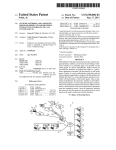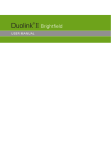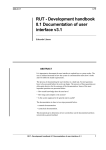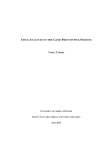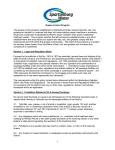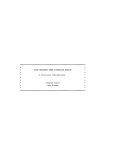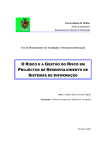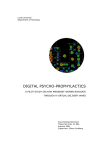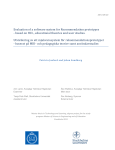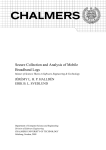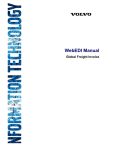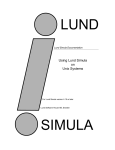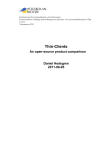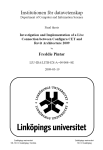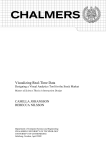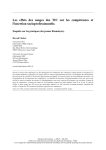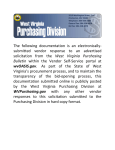Download The Importance of Utility wi of Utility within Information
Transcript
BSc Thesis in Human-Computer Interaction REPORT NO. 2008-008 ISSN: 1651-4769 Department of Applied A Information Technology and Department of Computer Science The Importance of Utility within Information Systems A Utility Study of Tech Tool Johan Albinsson Henrik Jansson IT University of Göteborg Chalmers University of Technology and University Univers y of Gothenburg Göteborg, Sweden 2008 The Importance of Utility within Information Systems A Utility Study of Tech Tool JOHAN ALBINSSON HENRIK JANSSON Department of Applied Systems Science IT University of Göteborg Göteborg University and Chalmers University of Technology Abstract This candidate thesis is written with the purpose to develop knowledge about utility and to understand utility in information systems.The actual problem we faced was to understand if a system provided the right kind of functionality for its users and also, if the utility provided was sufficient. A software suite developed by Volvo IT, called Tech Tool allowed us to practice our study and gain deeper understanding about utility in information systems. The empirical data used in this study consists of experiences from the respondents, gathered in a semi structured interview. Based on the empirical data acquired, we were able to understand the issues at hand and also helped us draw conclusions about further work needed to be done. The general utility provided by Tech Tool is sufficient in most cases but sometimes, user find it hard to complete their tasks due to errors or missing information or simply, lack of utility in certain areas. We also found out that usability played a vital role along with utility to create a usable system. This research was conducted at a Volvo IT office in Gothenburg. This report is written in English Keywords Utility, Usability, Functionality, Usefulness, Human-Computer Interaction (HCI), Interaction Design Acknowledgements We would like to thank the respondents for their achievements in the interviews and for taking their time needed for us to conduct the study. Their input has been vital and without them, we wouldn´t be where we are today. Thanks to Marie Eneman, our tutor at the IT University, for her much needed feedback and support given to us during our work with the thesis. We would also like to thank Marie Almlöf, our tutor at Volvo IT, who gave us the chance to conduct this thesis and for her insights within the research area and Marko Vainio, for letting us conduct the thesis at Volvo IT. Finally, our thanks go to the Tech Tool team at ARU2 who welcomed us and told us about the location of the Ping Pong table and other useful insights regarding our work. Index 1. Introduction......................................................................................................................................... 1 1.1 Purpose.......................................................................................................................................... 1 1.2 Delimitations ................................................................................................................................. 2 1.3 Thesis structure ............................................................................................................................. 2 1.4 Research setting ............................................................................................................................ 2 1.4.1 Volvo IT ................................................................................................................................... 3 1.4.2 Tech Tool ................................................................................................................................ 3 1.4.3 Guided Diagnostics (GD)......................................................................................................... 3 2. Theoretical framework ........................................................................................................................ 4 2.1 Human-Computer Interaction (HCI) .............................................................................................. 4 2.2 Interaction design.......................................................................................................................... 4 2.3 Utility ............................................................................................................................................. 5 2.3.1 Usefulness .............................................................................................................................. 7 2.4 Usability ......................................................................................................................................... 8 2.5 Differences between Usability and Utility..................................................................................... 8 2.5.1 Usability as a metaphor .......................................................................................................... 9 2.5.2 Utility as a metaphor .............................................................................................................. 9 3. Methodology ..................................................................................................................................... 10 3.1 Method of choice - Interviews .................................................................................................... 10 3.2 Data Analysis ............................................................................................................................... 11 3.3 Selection of respondents ............................................................................................................. 11 3.3.1 Respondents ......................................................................................................................... 11 3.4 Interview questions ..................................................................................................................... 12 3.5 Quality assurance ........................................................................................................................ 12 4. Results ............................................................................................................................................... 13 4.1 Identification of Vehicle / Machine (ID V/M) .............................................................................. 13 4.2 Settings ........................................................................................................................................ 14 4.3 Help ............................................................................................................................................. 14 4.4 Guided Diagnostics (GD) .............................................................................................................. 15 4.5 General question about Utility and Usability in systems. ........................................................... 16 5. Discussion .......................................................................................................................................... 17 5.1 Identification of Vehicle / Machine (ID V/M) .............................................................................. 17 5.2 Settings ........................................................................................................................................ 18 5.3 Help ............................................................................................................................................. 19 5.4 Guided Diagnostics (GD) .............................................................................................................. 19 5.5 Own reflections ........................................................................................................................... 20 6. Conclusions ........................................................................................................................................ 22 6.1 Outcome ...................................................................................................................................... 22 6.2 Generalization of results ............................................................................................................. 22 7. Proposition for future works ............................................................................................................. 23 8. References ......................................................................................................................................... 24 Appendix 1. Interview Questions - Utility study ................................................................................... 26 Appendix 2. Screenshot of Identification of Vehicle/Machine ............................................................ 28 Appendix 3. Screenshot of Help .......................................................................................................... 29 Appendix 4. Screenshot of Settings ..................................................................................................... 30 Appendix 5. Screenshot of Guided Diagnostics ................................................................................... 31 Appendix 6. Screenshot of Guided Diagnostics – Tree structure ......................................................... 32 1. Introduction According to Mathiassen et al (2001) system development is about adapting a specific system to the user’s needs. It is a process of several stages where the developers first receives an order for a computer system, then constructs a requirements specification, then writes the code and then tests and implements the system. For thirty years this process has been refined and improved and the results shown today is a large variety of different methods. Common for all computer systems are that they are developed for a specific reason. It can be a system that needs to be connected with other systems to better fit a specific purpose. They can also be developed for users which need to perform certain tasks. Either way, systems needs to be developed according to requirement specifications to fit the right purposes. It is of major importance that requirements specifications are correct and matches the customers’ demands as good as possible. During the time when the requirements specification is created users needs and demands must be captured and processed. This is of great importance simply because the users are the one who will interact with the system (Löwgren & Stolterman, 2004). All though user-centred development is of great importance (Faulkner, X (2000) & Gould, J, (1987)) it’s not as simple as the author claim. Capturing all the needs isn’t very easy, and not very lucrative. This would require much more time from the developers. The system being developed often contains the most essential demands which would satisfy most users, but some parts may be missed. This is why utility testing is important. This process identifies which functionalities that are being used and which are missing, thus telling if the system is useful or not. “Utility refers to the extent which the product provides the right kind of functionality so that users can do what they need or want do.” (Preece et al, 2002) Utility implies on the same foundation as usability, to enrich human experiences. Good utility in systems is essential for the users to carry out their tasks. Without proper tools, users can’t work with the system as it was intended. Focus on functionality is therefore of significance, and this is measured by how much utility a system delivers. Measuring utility in systems gives an indication on how the embedded functionality is helping the user. A high grade of utility allows the user to carry out their entire job without having to use other programs. A low grade utility system only contains a few tools which force the user to rely on other systems to complete his or her task, thus, creating frustration. 1.1 Purpose The purpose of this thesis is to develop knowledge about utility and to understand utility in information systems. This will be done by answering the following question: Does the system provide a suitable set of functions that allow users to carry out their everyday job in the way they need to do it? The term utility refers to the extent of functionality a system provides to the user. Functionality in this case refers to the amount of “tools” that is provided by the system. These tools enable the users to carry out their normal tasks during their work (Preece et al, 2002). 1 Within the area of HCI, usability and usability testing is widely explored and recognized. Less research has been made in the area of utility and its importance. Therefore this study aims to develop knowledge about the subject. 1.2 Delimitations This study will focus solemnly on utility and its importance for user satisfaction. We will discuss some aspects of usability since this is a large area of HCI, but main focus will still be on utility. Furthermore, this thesis focuses on what the end users experiences are with Tech Tool and Guided Diagnostics. We will not look at other components within the Tech Tool framework due to time constraints. 1.3 Thesis structure Chapter 1 (Introduction) includes background information about the thesis and what we are going to study. It also describes the purpose and the delimitations. We will give a short description of the systems, Tech Tool and Guided Diagnostics and their purpose and how we got in contact with AB Volvo to carry out our thesis. In chapter 2 (Theoretical framework) we give an introduction to the terms of utility and usability. The purpose of this chapter is to give a better understanding about these two subjects and relate them to the work we will do. It also contains information about HCI which will highlight the problem area with existing information about usability and utility. We will present existing studies that have investigated the same area and we will use this information to better explain our main question. In chapter 3 (Method), we will present the method for our study and how the empirical data will be collected. We will also present the respondents who will be the group for the interviews and how the interviews will be carried out. The results from the interviews will be presented in chapter 4 (Results). The last chapters, 5 & 6, will contain our discussion and conclusions gathered from the thesis. These chapters will also connect the different parts from the study and give answers to our main question. We will interpret the results from chapter 4 and relate them to the theoretical framework presented in chapter 2. Chapter 7 will contain information about future work propositions. 1.4 Research setting This thesis is carried out at the Bachelor programme of Applied Systems Science at the IT University in Göteborg, Sweden. During our time at the university we have developed an interest in the field of HCI simply because we like IT and what you can do with it. For us to be able to practice these areas, a contact with Volvo Information Technology (later known only as Volvo IT) was made. We got in contact with persons at Volvo IT who wanted to examine the utility within one of their systems, Tech Tool. After some meetings we agreed to carry out this thesis. During our time here at Volvo IT we hope to better understand the importance of the right kind of functionality for end users and what the wrong kind of functionality could result in. 2 1.4.1 Volvo IT Volvo IT is a global company and part of the Volvo Group and is a wholly owned subsidiary of AB Volvo. The company provides solutions for all areas of the industrial process, and offers unique skills and expertise in product lifecycle management, SAP solutions and IT operations. Some of the clients are the Volvo Group, Ford-owned Volvo Cars and other large industrial external companies (www.volvo.com/volvoit/global/en-gb). 1.4.2 Tech Tool Developed by Volvo IT, Tech Tool is a platform on which a number of applications are collected and arranged to create a simple yet powerful suite of programs for the user. Tech Tool allows a technician to simply connect the vehicle to a computer, and the system instantly tells the user all the information that the users need to carry out regarding a repair or maintenance of the vehicle. Tech Tool can also be used for diagnostic tests, calibration and programming of the electronic control unit (ECU), guided diagnostics and service information. Before Tech Tool, these application where separated from each other and the user was forced to switch between these applications which was confusing and non-productive, hence the purpose of Tech Tool. The purpose was to create a common integration platform for different software tools in the workshop to support the process of vehicle fault tracing and repairing. Besides being an excellent tool for technicians in the workshop, Tech Tool also provides roadside support when test driving vehicles. The main end users of Tech Tool are technicians at Volvo, Mack and Renault. In the future, Volvo hopes to adapt Tech Tool to support vehicle fault tracing in factories along the production line before the car reaches its final production state. The business principles that describe Tech Tool are: Shorter vehicle downtime (faster fault recognition and repairing) Provide the technician with a much easier way to identify and recognize problems Warranty savings A user friendly application which would require a maximum of one day training Adaptable to different business areas Single sign-on and common session data saving which saves time for the user 1.4.3 Guided Diagnostics (GD) Guided Diagnostics is a tool which is accessible from Tech Tool. The application lets the user specify what kind of different errors there is on the vehicle that needs to be repaired. Guided Diagnostics is a fault tracing application that guides the user to relevant tests to find out what the problem is, and then guides the user how to repair it, telling him/her which tools are needed and where the broken part is located. The workflow is controlled by a tree structure which breaks down into different areas, the faulty part is specified, or the area, then a diagnostic is shown, then the guided repair starts and tells the user how to continue the work. 3 2. Theoretical framework To clarify the research area, we must define the following concepts to further understand the significance of these terms. In order to make the study more logical and also to connect it with similar studies, a theoretical framework is needed for the theories which concern the study (Björklund & Paulsson, 2003). 2.1 Human-Computer Interaction (HCI) “Human-computer interaction is a discipline concerned with the design, evaluation and implementation of interactive computing systems for human use with the study of major phenomena surrounding them.” (Hewett et al, 2007) The ACM SIGCHI Curricula for Human-Computer Interaction describes that HCI is a study between both the mechanism side and the human side. At the same time, HCI is an interdisciplinary area with focus in several disciplines, each with different emphases: computer science (application design and engineering of human interfaces), psychology (application of theories of cognitive processes and user behaviour), sociology and anthropology (interactions between technology, work and organizations) and industrial design (interactive products). All together, the authors of ACM SIGCHI Curricula state that one need knowledge about both the human and the computer to get the whole picture. On the computer side, we need to know about graphics, operating systems, and programming languages and so on. For the human side, we need knowledge about communication theories, linguistics, social science and cognition (ACM SIGCHI Curricula). In this thesis, we are not able to describe all of these areas; it would be too large and out of boundaries. But it is important to get a great understanding of how HCI is built up. This will help us connect the purpose of our thesis. We will hopefully see and reflect over things that wouldn´t come to our mind, if we didn´t explain them first. 2.2 Interaction design Interaction design is the process, within limited resource boundaries, which create, form and determine the characteristics (structural, functional, ethical and esthetical) of a digital artifact for one or more clients (Löwgren & Stolterman, 2004). There are two ways to view interaction design; the first way describes usability and utility. Digital products are explained how they should fit in the appropriate context. They should be easy to use and support people and their tasks. This is a more academic approach close to the previously mentioned HCI area but also informatics. The other way of looking at it, is to view interaction design as a design principle, closely related to industrial design and architecture. With this in mind, focus lies on esthetical qualities and users experiences, but also on consumer products, entertainment and media production (Löwgren & Stolterman, 2004). In contrary to traditional graphical user interface design, interaction design involves the shaping of the systems behavior and flow. For example, how the menu system for a cell phone is to be shaped to let you work with it in a fast and simple way. 4 2.3 Utility According to Ottersten & Berndtsson (2002), utility is considered a quality characteristic of interactive products. A product has high utility if it fulfills the customer and the user’s purpose and demands. The utility of the product is visible together with the user over a period of time. To be able to create a usable product, the product needs to be designed with the following concepts in mind: The Human System o Generic qualities and patterns telling how individuals behave, recognize, view and remember information. o Specific qualities; attitude, values and expectations. The context in which the product is to be used o The physical context; low lighting conditions and annoying sounds. o The psychical context; stress or classified information o The social context; relationships, social status o The organizational context; main office, regional office, goods reception etc. The value the product is supposed to deliver o For the client providing the product; social benefits, organizational benefits or economical benefits. o For the user of the product; simplifying, effective or pleasure. According to Ottersten & Berndtsson, the utility term has changed a lot during the years. Utility was solemnly focusing on the human system but has evolved during the years and is now focusing on seeing the product in its complete context, involving the organization, the human system and the value the product is supposed to deliver. Due to functionality in products, a product with low functionality cannot be considered a high utility system even though it's shaped to fit the human system and its context. This implicates the meaning with utility in systems. Users and organizations need products or systems with high utility to carry out their work. Utility can be difficult to observe in systems; therefore the term "quality-in-use" was introduced. Quality-in-use defines utility as the following; Utility is a "quality-dimension". The products usefulness is dependent of its context in which it's being used. “Utility can be described as a measure of how well the system performs according to the users’ needs and expectations.” (Mathiassen et al, 2001) The following statements will be based on (Mathiassen et al 2001). The utility-criteria specifies that the quality of the system is outermost predicted by how well the system performs in its context. What this actually means is that the requirements specifications must be modeled so correctly that they support all kind of interactions in a specific environment and to a specific user. In order to interpret measure and understand how a certain design is performing, you need to consider it as a whole where you don’t care about its inner structure. 5 Mathiassen et al (2001) also points out that the observer needs to assume two complementary aspects to further understand utility: In which extent the design supplies the user’s needs. In which extent the design fits the technical platform. During the analysis, when the problem area is modeled and its functionality together with the interaction-demands is captured, the list of users’ needs and demands are created. These demands and needs are later on transferred to the requirements specification and forms a solid base which the system is then created on. One way to visualize new design ideas for an upcoming computer system is to use experiments, which purpose is to capture the goals and demands the users might have. An example of such experiments could be group activities combined of developers and users together discussing the shaping of the system. These activities often help explain both the users and the developer’s thoughts about the system and together they may find better solutions. There are other activities similar to this one such as brainstorming, the why, why, why model and the future workshop. It’s preferred that a complementary activity such as capturing of user demands is carried out in consultation with the creating of analysis documentation. The next important activity which the writers discuss is how to adapt the system to the technical platform. They articulate that the design of the system should be constructed so that it fits the technical platform in ways of hardware requirements but also that the performance impact of the program should be as limited as possible. The main issue that developers wish to eliminate is bottlenecks, a part of the system which isn’t optimized to the rest of the system. These bottlenecks doesn’t only bother developers but also users which may find the system awkwardly slow and non responsive which results in user frustration. Mathiassen et al (2001) means that a good design takes advantage of available resources and uses them in an appropriate way, but a bad design will slow the system down and overload the platform. The next issue is to rank these views after priority to utility. Mathiassen et al (2001) claims the importance of reflecting the following questions: In which extent should demands be implemented at the expense of the technical platform? In which extent should the quality of the platform be allowed to limit the systems functionality so that it doesn’t fully match the user’s needs? A lot of information is written about usability in systems but not specifically utility and its importance. This is mostly because utility is regarded as a product of usability and the amount of additional value the system generates. Never the less, we intend to focus on utility because the functionality within systems is directly connected with utility. When requirements specifications are created, the customers work will be to compile a list of demands which contains all the wishes and desires the users would like to have in the upcoming system. 6 “To formulate demands on an imagined IT-system is very difficult. The one who formulates the demands is expected to fully understand which characteristics and functions that creates surplus value but must also express these in a formally and correct way” (Ottersten & Berndtsson, 2002) An idea or thought which concerns requirements specifications is often formulated long before the actual development work has begun. These demands are made up by people who often have no experience in the area of which the system is to operating in. This can result in users that doesn’t get the right kind of functionality they once requested (Ottersten & Berndtsson, 2002). It is important that as early as possible capture the most essential and limited demands. According to Ottersten & Berndtsson (2002), creation of requirements specifications is comprised of three main activities: Mapping of ideas. Target group analysis. Specification of demands. As a system developer, the main goal is not to build the perfect system with unlimited resources. It’s more important to create a functional system which fills the needs and demands that the users have (Löwgren & Stolterman, 2004). The authors claim that these needs must be captured and measured in an early stage during the development process. This means that one must validate the product with the specifications for the system as long as the process proceeds. 2.3.1 Usefulness In September 1996 the Swedish IT-Commission wanted a report on IT and its usefulness. The purpose with the report was to establish an understanding of how IT could be used to better improve current processes and eventually, what impacts IT would have during the forthcoming years. One way to understand the benefits of IT was to look at its usefulness. They addressed usefulness, or utility as the following: when complicated user manuals are needed to perform tasks, problems occur. According to the report, there are methods which describe how to better achieve more usefulness or utility within systems but there is not enough common knowledge about this. Utility will never be important unless decision makers or IT-experts agree that utility is of importance when designing systems. The report states that one way to speed up the understanding of utility may be a pronounced usability policy where utility is better explained and enlarged. Regarding usability, the Swedish IT-Commission came to the following conclusion: improved usability equals improved productivity. What they meant was, if users can perform tasks with ease and with well designed systems, they would be more productive and that would lead to better and more efficient organizations. According to Jakob Nielsen (Kaasgaard, 2000) usefulness is a combination of usability and utility. He claims that utility means “What is it doing?” and if it does something that nobody needs, then that is not going to be a particular useful product. On the other hand, if you have something that does what you need but you don´t know how to do it, there is no usefulness in the product, so it is important to remember that usability and utility goes hand in hand. 7 2.4 Usability Usability can be described as the relationship between systems and their users. It is one area of the field of HCI and has to do with bridging the gap between people and machines. “The main reason to be concerned about usability is a desire to enrich human experience” (Whiteside, J & Wixon, D, 1987) For a system to be effective, the users must accomplish their tasks in the best way possible. The usability of a system depends on a number of factors; how well the functionality fits users needs, how well the work flow through the application fits users tasks and how well the response of the application fits users’ expectations. We can learn the design principles (Preece et al, 2002) which we will be mentioning later to design better interfaces. However, it is equally important to get information from the people who will actually use the system. Usability is the quality of a system that makes it easy to learn, easy to use, easy to remember, error tolerant, and subjectively pleasing. This is important because it makes the difference between performing a task accurately and completely or not. The task must also be enjoying and not frustrating for the user. From a management point of view, bad usability can reduce the productivity of the workforce to a level of performance worse than without the system. To design a system with high usability, iterative design is a key principle. It is important to get feedback from users and clients during the whole design process in order to meet the requirements. Another method for ensuring high usability is letting the actual users test the working system. When this is done, more feedback is presented and the system can be designed to better fit the users’ needs and demands. (http://www.usabilityfirst.com/intro/index.txl) 2.5 Differences between Usability and Utility Due to the differences between the Swedish and English language, terms are somewhat mixed up and confusing and the original intention of the terms can be misunderstood. Therefore we feel that a thorough explanation is needed. The first thing is to separate usability and utility in order to see the difference between them. According to Preece et al (2002) utility is one of six usability goals. These remaining five are effectiveness, efficiency, safety, learnability and memorability. To further understand the position and meaning of utility in the context of usability, we would like to describe the remaining five usability goals (Preece et al, 2002). Effectiveness describes how good a system is at doing what it is supposed to do. For example, an effective program lets people access the information they really want, or buy the products they want. Efficiency refers to how good the system is at supporting the users to carry out their tasks. An example for this can be a telephone which lets the user call other people. Safety means that the system protects the user from dangerous situations. This could be a situation where the user can´t click on certain buttons to avoid the activation of specific functions in a program. 8 Learnability refers to how easy a system is to learn the use of it. Products in everyday use shouldn´t take too long to learn. People don´t want to go through manuals just to learn how to use e.g. a simple text editor. Memorability describes how easy it is to remember a system and how to use it, once learned. People who use interactive products often, don´t want to read a manual each time they need to use it. According to the ISO standard, 9241-11 ergonomic requirements for office work with visual display terminals (VDTs), there are three keywords that describe usability: Effectiveness (same explanation as above) Efficiency (same explanation as above) Satisfaction. This refers to which level of satisfaction and positive feelings the product delivers to the user when it’s being used. Tidwell (2006) mentions twelve behavioural patterns often seen in user observations. One of these is satisficing. You can connect this with the ISO keyword satisfaction, they booth mean how satisfying a system is for the user. Preece’s usability goals, the ISO standard and Tidwell’s behavioural patterns all complement each other in a good way. If you have all three in mind when you design a system, you will probably help users achieve their goals far more effectively than if you didn’t (Tidwell, 2006). The use of metaphors is a creative way to show the differences between the two terms. With the ability to use metaphors we are able to visualize concepts in new ways and transfer ideas and experiences from one area to another (Mathiassen et al, 2001). 2.5.1 Usability as a metaphor Imagine an ordinary door with a handle the way it’s usually placed. When the handle is pressed down the door opens as usual. If the handle would be placed at the top of the door and needs to be pushed upwards then the door would be less usable. (http://www.lumano.se/branschinfo/artiklar/anvandbarhet.php). “For us, software usability refers to the extent to which software supports and enriches the ongoing experience of people who use that software.” (Whiteside & Wixon, 1987) 2.5.2 Utility as a metaphor If we choose to look at the door again to explain the term utility, the door should obviously lead somewhere, the sole purpose of a door. It gains access to something that is sought after. But if the door is opened and a brick wall is placed on the other side or it just leads to an empty space, the door would be considered useless because it doesn’t lead anywhere. To exemplify a system with high utility we can imagine a picture resizing program that allows the users to resize pictures. The only thing the program is supposed to do is resizing pictures and this is the only thing the users wants to do, hence the program has high utility. A system with low utility could be a drawing tool that does not allow the users to draw freehand but forces them to use only straight lines to create the drawings. This is a system with low utility. 9 3. Methodology This chapter contains information about which method we selected and how we conducted our research. There is also an explanation of why we chose the respondents that we interviewed. 3.1 Method of choice - Interviews To better understand what users feel about a system we could conduct questionnaires, interviews and/or observations. In this case, we feel that interviews are the most appropriate due to the quality aspect of interviews. A questionnaire tends to generate a lot of answers but we feel that interviews would be more suitable for this study. Observations are a great method to understand the users and their environment. However, observations tend to be time consuming and the results can be hard to interpret. Observers can sometimes have a hard time to discern if the user is behaving normal or not. The reaction of people can also be different from time to time; they can be affected by either stress or disturbances (Patel et al, 2003). However, a negative aspect of interviews is that they are time consuming (Björklund et al, 2003), which will draw time from other important matters. Interviews can also be expensive due to traveling back and forth because of the geographical location of the respondents. The purpose with a qualitative study is to explore and identify characteristics and opinions in the respondent’s world or environment (Patel et al, 2003). According to Björklund et al (2003), primary data collected from the interviews will give useful information on how to conclusions are to be drawn from the study, this will also help us to better tie our purpose with the study. The idea with interviews is to discover and identify characteristics of something. This implicates that one never in advance can formulate the answers to the questions or determine what the "true" answer for a question would be (Patel & Davidsson, 2003). According to Björklund & Paulsson (2003) interviews can give access to information that may be of direct relevance which we believe to be useful with the purpose of our study. We will also be able to translate the respondent’s body language and other human signals in order to get better data for the study. On site interviews, allows us to be placed in the users’ natural environment (Tidwell, 2006). To remember everything from the interviews, we used a tape recorder which allowed us to listen to the interviews again. Along with notations from the interviews, this was very helpful when we were transcribing all data that was collected for the study. Through our tutor at Volvo IT, we got in contact with a person at Volvo Trucks. He had, on our behalf, contacted several FSEs and PQEs (FSE, Field Service Engineer & PQE, Product Quality Engineer). The FSEs and PQEs were the respondents which we interviewed. The number of respondents for this thesis was limited to 4 due to time consumption and delimitations. We gained access to these people by our contact at Volvo Trucks by e-mail and telephone. All of the respondents was briefed on what our purpose with this thesis was and agreed to be interviewed if time where available. In case of loss of respondents we could establish contact with other similar people. The interviews took approximately 40 minutes to one hour, which we think is reasonable. This is because we wanted the respondent to feel that he or she where in a relaxed environment and that they felt no need to rush their answers. We hoped that this would make the respondents more comfortably and that it would lead to better and more complete answers. Two of the interviews were conducted at the respondents’ office, one down on the shop floor and the last one was 10 conducted over telephone. We also asked the respondents if it were ok to conduct interviews with them and we received an ok from all of them. They were also asked if recording was allowed and that they participated freely and anonymously. 3.2 Data Analysis The data analysis consisted of three stages. The first stage started with the transcription of the material. The transcription process offers the opportunity for reflection on the data and attention to emerging themes and should be seen as an integral part of the analysis process (Silverman 2005). The material was then read and re-read through. Some initially notes were also taken to comment the material. In the next stage the material was structured and coded manually in relation to the themes: Identification of vehicle/machine, Help, Settings and Guided Diagnostics. During the last stage, subjective meanings were searched for and differences and similarities were identified among the themes (Silverman, 2005). 3.3 Selection of respondents Our initial thought was to interview the technicians on the shop floor since they use the program daily. However, we gained an understanding about this from a meeting that not all workshops were at the same level of experience. Also, we learned that there are people at Volvo who represent a large number of technicians. Interviewing these people may give us the experience of many more technicians than we would have covered, interviewing only four technicians, according to personnel at Volvo. Field Service Engineers are the employees who sum up all thoughts and aspects of Tech Tool. These were the people that we interviewed, and also, the educators of Tech Tool since they had a great deal of knowledge about user’s feelings and opinions. The educators where also important because they teach all new technicians on the system. These concepts will later on be known as FSE and PQE. 3.3.1 Respondents Respondent 1 61 year old male who has worked in the business since 1970. The person claims that he has good knowledge in computer based work. His role is field service engineer and technical support for the workshop and clients. Has very good knowledge about Tech Tool. Respondent 2 45 year old male who has worked in the business since 1980. He has acquired computer habit through his work experiences but is no expert according to himself. His role is technical training manager. Has very good knowledge about Tech Tool. Respondent 3 34 year old male who has worked in the business since 1992. He has good computational habit. His role is mechanic. Has good knowledge about Tech Tool. Respondent 4 40 year old male who has worked in the business since 1998. He has acquired computer habit through his work experiences; medium skilled but has very good knowledge about Tech Tool. 11 3.4 Interview questions According to Patel & Davidsson (2003), a question which tends to explore a certain matter needs to be structured. Questions should also be written with a low grade of standardisation, which allows the respondent to answer freely. We wanted to direct the questions to the subject we explored; therefore we wrote these questions with some structure but with a low grade of standardisation. Standardisation allows the writer to maintain focus within an area, directing the conversation but allows the respondent to answer freely within the area under discussion. Our questions are semistructured and with a low grade of standardisation. The questions explore the different aspects of utility within Tech Tool. The questions range from how much of the utility within a program is used to the lack of utility that might be missing. We also ask the users how they would like to shape the program and what parts they don’t like and why. These questions will help us to understand what users feel about Tech Tool’s utility and what they need from it. The questions we chose were focusing on utility within Tech Tool. We asked the respondents about their feelings on different components within Tech Tool such as Identification of Vehicle / Machine (which is the start up screen where the user identifies the vehicle), Settings and Help (contains information about different connection methods and user help on how to work with Tech Tool) and Guided Diagnostics (helps the user specify symptoms and carry out diagnosis of the faulty vehicle). The questions also included what kind of functionality that eventually could be missing and what they thought about existing functionality and if that functionality helped them with their everyday tasks. 3.5 Quality assurance It is important to ensure that the study we were conducting was trustworthy, that the credibility was high. In order to test this, we went through the two concepts: validity and reliability. Björklund et al (2003) say that many authors claim the importance of this in scientific studies. Validity: validity means in which extent you are measuring what you really should measure. Reliability: this means how much the reliability is within the surveying instrument used. In which extent will you get the same values if you repeat the study? Patel et al (2003) uses a metaphor of a dart board to give a better description of the subject. If you have high validity and reliability, the arrows thrown, will be close to the bull's eye. In our case, we tried to make the interview questions as clear as possible. We didn't want to control the questions, so that the answers would be what we wanted. We also asked sub questions to further underline the questions. 12 4. Results According to Patel et al (2003), the acquired empirical data should be used to answer the main question. With this in mind, it’s appropriate to formulate the results based on the main question. Underneath, we will only present the data collected from our study. The result chapter will not contain our own thoughts and experiences, only the respondents. The empirical data collected gave us information about four areas of interest. These areas represent different parts within Tech Tool. These areas were in focus because it was best suited for our purpose. To be able to answer our research question we needed to focus on these areas within Tech Tool because they are dependent on high functionality and utility. These areas are: Identification of vehicle/machine Help Settings Guided Diagnostics We created our interview questions so that they explored those areas and our results are structured according to the way we asked our respondents the questions. In our method we described that we estimated the interviews to take about one or two hours depending on the respondents will to answer. However, they ranged from 30 min to an hour. This could be the result of the respondents’ actual knowledge on the subject or due to the differences in human beings. Some people like to describe things in a short and structured way, others tends to talk more freely and also to involve other subjects which they might find important. We don’t believe that the data collected were less informative or bad because of this. We found the data to be rich in information and to contain lots of useful feedback. 4.1 Identification of Vehicle / Machine (ID V/M) In general, the functionality within this part of the system is satisfying. People feel that they can carry out their tasks that they are supposed to do. In this part of Tech Tool, the users can identify the vehicle through a connection, established by either USB- or COM-port. Users can also choose to look at earlier connected vehicles and they feel that this functionality is helping them. When we asked the respondents what their experiences were regarding the utility in Identification of Vehicle / Machine, they responded as following: Respondent 1 said that he felt that the information fields was somewhat unnecessary, obviously he knew what vehicle he had connected and didn’t need a reminder of this. Respondent 2 said that connection to other systems is a bit slow due to heavy traffic on the internet connection, but he in general feels the functionality to be sufficient. In contrary to respondent 1, he thinks the information fields to be good. Respondent 3 thinks ID V/M is good, it’s helping him do his everyday tasks, although, ID V/M is today much better then what it used to be. “The information presented is enough, it’s good” 13 Although, respondent 4 said that this part of Tech Tool is complicated and time consuming, mostly because the sign on and identification procedure is circumstantial due to multiple choices and questions to continue. “Well, there is a lot of useful information but it is too circumstantial to get started.” Respondent 4 also mentioned the delays in communication between the different services in Tech Tool. He can perform his daily task, but with some frustration. 4.2 Settings The questions we asked about utility in the settings-tab in Tech Tool generated some issues. We asked if the functionality was sufficient and if it was easy to work with the different fields that are presented to the user. Respondent 1, 2 thinks that the settings-tab needs some serious changes in order to help them and says that the connection tab is hard to understand and they feel that it’s unintelligent of the system not to recognize which interface they have used to connect the vehicle. Respondent 1 is irritated because the system forces him to reconnect the vehicle in order to identify it once again after he has chosen which connection interface to use. Respondent 2 says that the terms used are cryptic and hard to understand. Respondent 1 says that he has no clue what the WEP setting is and that he is confused when asked to enter a 24 character key to continue. Respondent 1 also says that the WEP-key is very much needed because otherwise the system will connect to the first available vehicle over WLAN and he will have no clue which vehicle the system is connected to. Respondent 3 however thinks that this step is simple; the functionality under the settings-tab is easy to work with because he has a lot of experience from this part and he also believes that the general feeling about this part of the system will get easier the more you use it. Respondent 4 has too little experience to give any useful information; he has hardly ever used it. “I had a different opinion six months ago and now I better understand the program and the different choices” 4.3 Help Here we asked the respondents what their experiences of the help-tab were and what they thought about its content. We also asked about the functionality within the help-tab and if it was useful. The Help-tab contains a user manual and information about different settings and such. “I have never used the help-tab” Respondent 1 has never used it because he relies on trial and error and has never been forced to look into the manual. Respondent 2 thinks that the help-tab is useful and explains what needs to be explained. He likes the search-functionality and he feels that the help-tab is good because it’s digitalized. He explained for us that he is satisfied that the help-tab is integrated with Tech Tool because paper manuals gets old, this way, it’s always up to date. 14 Respondent 3 has never used the help-tab and neither has respondent 4. 4.4 Guided Diagnostics (GD) This program within Tech Tool contains the most functionality, it was therefore important for us to ask the users on the different aspects of utility to understand what functionality that is required of the users and what they feel about it. All respondents agree that the purpose with Guided Diagnostics is good. However, respondent 1, 2 and 3 says that GD is only capable of solving easier problems. The problem seems to be the lack of symptoms used to describe what’s wrong with the vehicle. This forces respondent 1, 2 and 3 to use other systems to back trace the problem. Respondent 1 main issue with Guided Diagnostics is the lack of symptoms; this is also confirmed by respondent 2 and 3. Respondent 4 complains about the lack of information in GD, he has to rely on other systems within Tech Tool to get the information he needs. GD contains too little information about control-units and ECU: s. “If Guided Diagnostics gets better, people will use it” “System delays in GD is annoying” Respondent 3 says he likes GD, but it depends on how complex the problem is. If he runs out of symptoms to describe the faults he can’t look in other systems because all newer vehicles have their data stored in GD and nowhere else. Respondent 3 is also annoyed with GD because sometimes when he does testing on vehicles, the system tells him that there are no faults but he knows that the vehicle is broken. Guided diagnostics fails to identify the problem. Respondent 4 would like to have more symptoms and fault-codes to better help solving problems but he believes that it is too circumstantial to get to the point where he actually can find out what’s wrong with the vehicle. He also thinks that GD should be more open, GD: s workflow should be less forcing. He wants’ more freedom, simpler navigation and the ability to skip certain steps in the workflow. Respondent 4 believes that GD is sometimes useless because he is redirected to other systems to read critical information, but sometimes there’s no information where he is linked which forces him to stop. He can’t continue his work. This problem is common for all respondents; they have several times ended this way when trying to solve problems. Respondent 2 says that no matter how good a mechanic you are, after three of four steps working with GD, you have completely put all your intellect aside and is now focusing only on GD and its’ workflow, you forget think for yourself. It’s to inhibiting. “GD should have two interfaces, one for expert technicians and one for beginners, this will let the more advanced users skip all the unnecessary steps and focus on measurements and such” This is confirmed by respondent 1 who also says that GD sometimes can make users stupid, they tend to forget to use their own skills. “I think the major problem is that people trusts GD to much” “When there’s no information in Guided Diagnostics, I can’t continue my work, I’m stuck!” Respondent 2 is concerned that mechanics in ten years time will be completely dependent on systems like GD to complete their work. 15 “GD is to slow and circumstantial.” Respondent 4 would like to have an easier way to obtain information, there are too many steps to go through to get where you want to. Respondent 3 thinks it is strange that users aren’t informed on updates in the system, new buttons and functionality is installed and he has no clue what they do or when they were implemented and if he should use them. Respondent 4 also mentioned this, he has no idea when updates are available and has no clue if the system has updated since the last time he used it or what the changes was. Respondent 2 tells a story about a broken headlight: -In GD I think its 26 steps to confirm fault, check and replace the headlight; this will take about 45 min! A good mechanic can do this very much faster, GD is way too much circumstantial. Respondent 1, 2 and 3 says that GD has great images which explain how to repair and what tools are needed. This part is considered very useful by our respondents and explains well to them how to carry out repairs and work with different tools. 4.5 General question about Utility and Usability in systems. We wanted to know what users knew about functionality and usability within systems, therefore we asked our respondents what their thoughts were on this matter. All of the respondents agreed that functionality is much more important than a nice and user-friendly interface. However, they felt that a good system contains both high utility and an easy to use interface. Their thoughts on Tech Tool were in general that the utility was satisfying but the userinterface and the logic of the workflow was inhibiting and not efficient enough. The functionality exists but is repressed by the interface. 16 5. Discussion The main purpose of this discussion is to evaluate what the respondents’ experiences about Tech Tool were and to establish a general thought on how each part of the system performed. We also need to connect the discussion to our theoretical framework, purpose and to evaluate the results (Backman, 1998). According to Patel et al (2003), it is important to reflect over the study and the outcome of it. This means that we have to evaluate our study and describe how it went according to our expectations. We have seen some elements that may inflict on the results acquired. One of those is the fact that the respondents are only males. Another issue that may have influenced the study is our interviews. Perhaps we have asked the questions in a way that affected the respondents’ answers negatively? Maybe the respondents felt they were inferior to us in the context of knowledge surrounding information technology and particularly human computer interaction? We asked ourselves what kind of answers we were looking for. Does the system provide a suitable set of functions that allow users to carry out their everyday job in the way they need to do it? This question might be simple but the answers we got where not obviously yes or no. The system does provide some users with everything they need, although some might find it lacking in functionality. This discussion will clarify our thoughts regarding the question and its answer. 5.1 Identification of Vehicle / Machine (ID V/M) The summarizing concerns of ID V/M were in general good. The functionality or utility provided was sufficient and useful, connections to other systems are working the way it should and the information provided by the system is good and informative. With this in mind, the utility exists for the users. As Ottersten & Berndtsson (2002) says, the utility fulfills the users’ needs and demands. This is, after all, the quality characteristic of an interactive product. The project-team of Tech Tool has taken many concepts in consideration, especially regarding user interaction. Mathiassen et al (2001) is also talking about, and emphasizing the need of utility in systems. The utility is high if the system performs well according to the users’ needs and expectations. What the respondents meant by telling us that Tech Tool was slow was that delays occurs when signing on and delays also occurred when opening subsystems and connecting the vehicle to ID V/M. When a system cause user frustration, something has obviously gone wrong. This doesn´t necessarily mean that the system has low utility. Many of us know that a computer system sometimes can fail, even though it is generally a good system. But to minimize the risk of user frustration, it is important to catch these complains in an early stage, so that the faults can be corrected. The user frustration can, however, inflict on the user satisfaction. According to the ISO standard, Preece et al and Tidwell, this is needed to take into consideration. What we learned is that users are mostly satisfied with ID V/M and no other functionality was needed. We also learned that too much functionality tends to distract the user. With this in mind, we see again that user satisfaction is important. If we connect this to Löwgren & Stoltermans (2004) statement that the main goal is not to build a perfect system with unlimited resources, the user satisfaction gets clearer. It is not particularly important to implement a lot of functionality if the users 17 set for less. This will only cost money and time, both which are very important in organizations of today. The most important thing is that the system actually delivers what the users need. Users will always have different opinions on systems due to the nature of human beings and users will always find different parts they like or dislike. The ACM SIGCHI Curricula for Human-Computer Interaction states the need to look at both the human side and computer side of systems. Some people that have greater knowledge in working with computers, may see different on a particular system as well as people with less understanding will see it another way. A challenging task when constructing and designing interfaces is to deliver an interface which pleases both advanced and novice users. This can be done in several different ways, but one good example is to have a basic and simple, yet useful interface which allows expert interactions. This can be supported by short commands or similar. The use of graphically enriched user interfaces may please some users, often more novice users then expert users which tend to request pure functionality over esthetics and guidance. Mathiassen et al (2001) points out the importance of adapting the system to fit the technical platform, if not, user frustration may occur due to lags or delays which may be a result of poorly written applications without proper understanding of software requirements. This may be a reason why users experience delays in Tech Tool, we don’t know for sure but we don’t believe that Tech Tool is badly constructed, but these delays can be caused by similar issues. Another issue that may cause delays might be problems with ISP: s (Internet service providers), faulty maintenance of routers, switches etc. In any way, these problems causes frustration for users which may result in loss of work hours and in worst case, lost of profit. 5.2 Settings From what we heard from the developers of Tech Tool, there were some already known issues with the connection settings in Tech Tool; they however didn’t tell us exactly what was wrong with it. The only assumption that we had was that something wasn’t working as intended. The insecurity respondents felt can be connected to the time spent with computers. Computational habit seems to be a vital part for better understanding information systems etc. We looked at how good computational skills our respondents had and in general, all of them had pretty good knowledge with computers. Although, it is important to make the digital artifact fit in its context. A system developed for the automation industry cannot be developed for ordinary people; however it can be adapted to support novice users even though the system is advanced. The user interface is playing a vital role delivering utility to the user. The respondents who liked the settings-tab had learned their way by trial and error, learning by doing. Perhaps some users aren’t afraid of trying new solutions, which helps them find new ways to do things. This behavior should perhaps be encouraged during training to make the users feel safer when working with Tech Tool. If the system lacks some utility, maybe the users will find other ways to solve a problem. This can be the result of bad system development. If the purpose of the system isn’t achieved, user might find other ways to work with it. Maybe there aren’t so many things to consider in the settings tab from a utility point of view. However, it is important that if users can’t connect to the vehicle in a simple way, they can’t for sure solve their everyday tasks. This is a place where interaction design must be taken in consideration; 18 there is a need to capture both how the users interact with the system, and later on how the system interacts with the vehicle. These two points of views are reflected over when you talk about HCI. 5.3 Help An assumption made by us was that the main part of all users of information systems never or seldom tends to use the help or similar guides on how to work with the system. This assumption was confirmed by most of the respondents which said that they never had used the help-tab. Most of them relied on trial and error and only saw the help-tab as useful if they by no means got forward with their work. One benefit of having a digitalized help is that it never goes out of date since it’s being updated every time there is a change or update and because paper manuals tends to disappear. If we summarize the information gathered in our theoretical framework, can it be that simple that if the system has high utility, a help tab isn´t needed? We think that this isn't the case. Although, if a system has high utility, the user may sometime end up in a situation where he simply has forgotten something. Even though the user may be an expert, he can run into situations he hasn't faced before and will then need somewhere to go to find answers. 5.4 Guided Diagnostics (GD) GD is a complex system, containing guides, decision trees, calculations etc. To build a fault free application like this is a huge task, we therefore expected to hear some issues about the system. However, we didn’t expect that GD was not working well, our own experience from GD was far more positive then we would later on receive. We were a bit surprised by the vast feedback we received during our interviews. There were some positive feedback but we received a lot more negative feedback which was a surprise for us. Time consuming applications results in low efficiency and effectiveness, two of the usability goals described by Preece et al (2002), which in worst case leads to loss of profit for the company. Users of GD seem to experience user frustration and efficiency issues when working with the system. This can be solved by addressing some of the issues we mentioned. One of the most important issues according to our respondents is the lacks of symptoms used to describe faults with the vehicle. An increase of symptoms in GD would likely help more users feel satisfied with the system. According to the ISO standard 9241-11, user satisfaction is one of the key values when designing information systems. As we mentioned earlier in the theoretical framework, if designers were to follow the ISO standard together with Preece’s usability goals and Tidwell’s behavioral patterns, these issues might not have existed. In best case scenario, no big issues would exist at all. But it is also important to remember what Mathiassen et al mentioned, to fit the system to the technical platform. If not, designers might end up with a perfect user interface or information system which isn’t applicable to any existing hardware. A blend of high utility, high usability and a perfect fit with technical platform, at lowest possible cost, is what all designers or developers are looking for. The negative experiences with the logical structure have something to do with poor usability. The mechanics do not want to be frustrated when working in the system. This is something that has to be corrected when the system is being developed. Even though a user can solve his or her tasks (utility), 19 it is not necessarily going to be satisfying. As with the metaphors mentioned earlier, a door can lead somewhere the user wants to go but if it this step is hard to do, the user will be annoyed. The last major complaint about GD, which was confirmed by almost all respondents, was that GD is way too circumstantial. One of the respondents (was also mentioned in the results chapter) mentioned that a simple task such as switching a head light could take up to 45 min when using GD due to the restrictions made by the developers. On the positive side, the respondents are well aware of the purpose with GD and believe that it is a great way to help the mechanics. We received a lot of positive feedback on the pictures and guides that GD have, these are very useful to help change faulty parts or helping out with measurements or simply to identify different parts on the vehicle. The Swedish IT commission came up with the conclusion that if complicated manuals are needed, problems occur. This can be tied together with the positive feedback for GD, only the other way around; easy and useful manuals will help the mechanics work a lot more satisfying. This will then lead to improved productivity, which is exactly what Volvo Trucks wants and any other organization for that matter. In our theoretical framework we wrote about usability and what a system with high usability is made up of. Usability defines how easy it is to learn a system, how easy it is to use, how error tolerant it is and how subjectively pleasing it is. All these parameters define how usable a system is. Is GD a usable system? Yes, in many ways, but also no. On the positive side; GD is easy to use, it contains a lot of useful information and also great images which explains for the mechanic how to conduct repairs. On the negative side; GD is easy to use, but the workflow, the logical structure of the query process inhibits the user in many ways as we described before. No matter how user friendly a system is, it is important to remember that usability and utility goes hand in hand. A mix of high utility and high usability is what users wants, and needs. We believe that GD will become better and more useful but the requirements-organization must listen to what the users need and what the users want from the system. User centered design is important, because the user’s needs must be captured and implemented early in the development process. This way, the system is shaped the way users want. This is one way to ensure that the product will be useful and used the way the developers intended. 5.5 Own reflections From our own experiences and conclusions, we can understand some of the respondents’ feedback on Tech Tool. Tech Tool is comprised of several different applications which are accessed from one single interface. Due to this background of the system architecture, integration of true applications into one single system is a difficult challenge. It may work, but not as well as a system built from the beginning with this architecture in mind. The problems occur when a number of free standing applications are blended into one single system. Tech Tool is working very well, data is easily acquired from other systems and the user in most cases gets the information needed. However, because the system is comprised of different applications, the general feel and look is not common all over in Tech Tool. This generates issues when users’ switches between applications, buttons are not in the same place, they don't look the same and the general behavior of the applications is not the same. Because of the architecture, with servers and the use of Internet to send and receive data, lags can occur. In general, there are no big issues but when many users access the system at the same time, lags are inevitable. 20 One thing that came to us regarding utility is that we tend to accept utility the way it is, without thinking about its purpose. Perhaps users’ should question the purpose of functionality and be able to give feedback. This way, developers can redo that part. In most beta-versions of software (test version of the final product), users can submit bugs and crashes with a special form, perhaps this should be implemented with the final product, just to open up the dialog between the user and the developers. With good utility you get a satisfying system as long as the usability point of view is good. As we have stated before, utility and usability goes hand in hand. Without any of them, the system will fail and not give the satisfaction needed when interacting with the system. It is important to know that as a system developer, you might have a different opinion than the users. The users can be very different in terms of computer experience, age, profession, technical knowledge and so on. 21 6. Conclusions The purpose of this study was to develop knowledge about utility and to understand utility in information systems. 6.1 Outcome Tech Tool does generally provide the users with sufficient utility. However, there are some issues that sometimes inhibit the users to carry out their tasks. Tech Tool is today a useful and competent system, otherwise Volvo wouldn´t use it. Overall, the utility provided in the system is good, but sometimes it can go wrong, forcing the users to come up with workarounds. In those cases, the provided utility is failing due to what may be bugs or similar. From what we learned during the writing of this thesis, utility’s main role is to deliver functionality in an easy and useful way. Tech Tool is all about functionality. When technicians work with complex vehicles, such as trucks, they need something to rely on other than their own skills when they run out of options. Tech Tool delivers very good help for technicians through different applications and services. What actually seems to be a problem is that not all technicians are at the same level of experience which is shown by the feedback we got from the interviews but also, the above mentioned flaws in Tech Tool. The results from the study show how important utility is in information systems. If the system doesn´t take the user to a point where he or she need to be, then the system is useless for them and the tasks they want to accomplish can´t be done. The results gathered in the study are not surprising. It is easy to connect it with existing studies concerning utility and the aspects of HCI, showing the importance of utility. Designing the perfect system is today almost a utopia and it may take many more years to fully understand all parameters that affect the outcome of success or failure. We have seen and learned a lot to think of when developing computer systems, things that we might have not reflected over before. One of those things is to never underestimate the users since they are the ones who will use the system every day. By keeping an open dialog with users, the requirements-organization and the developing team may one day be able to perfect systems so they fit the users’ demands perfectly. Mathiassen et al (2001) claims the importance of adapting the system to the technical platform and adapting the system to users’ needs, however, it is as equally important to adapt the system to the actual environment. Also, adapting the system to fit in an ever changing organization is an important task. Utility is so much more than simple functions, utility form the backbone in all applications and shapes their purpose. Therefore, utility must be explored and taken into consideration. 6.2 Generalization of results How important is it with high utility in information systems? We would like to say; very important! It is also very important that utility goes hand in hand with usability because these two are strongly connected. This is commonly applicable for all information systems. 22 7. Proposition for future works We have only studied the importance of utility in information systems. There are five more usability goals to consider in a software development process. We think that these are all equally important to reflect on. However, the time spent on this study wouldn’t nearly be enough for examine all these aspects. Therefore, a thorough study of all six usability goals in context of system development would be an interesting thesis. It would also be interesting to see how humans actually interact with a computer system and study this phenomenon deeply. This could be done with a thorough observation of the users and from this, draw conclusions regarding the actual interaction between human and computer which may lead to better designed software. There are numerous methods used for development of software, which the best one is depends on what kind of software that is being developed. Some methods are more suitable for rapid development, some are more forgiving when user centered design is important. Perhaps a study concerning these methods together with usability goals could be a way to research software development. 23 8. References Books Backman, J. (1998). Rapporter och Uppsatser. Lund: Studentlitteratur. Björklund, N. & Paulsson, U. (2003). Seminarieboken – att skriva, presentera och opponera. Lund: Studentlitteratur. Bullinger, H-J. & Shackel, B. (1987). Human-computer interaction – INTERACT’87. Amsterdam: ELSEVIER SCIENCE PUBLISHERS B.V. Faulkner, X. (2000). Usability Engineering. New York: Palgrave. Kaasgaard, K. (2000). Software Design & Usability. Copenhagen: Copenhagen Business School Press Löwgren, J. & Stolterman, E. (2004). Design av informationsteknik – materialet utan egenskaper. Lund: Studentlitteratur. Mathiassen, L. Munk-Madsen, A. Nielsen, P A & Stage, J. (2001). Objektorienterad analys och design. Lund: Studentlitteratur. Ottersten, I. & Berndtsson, J. (2002). Användbarhet i praktiken. Lund: Studentlitteratur Patel, R. & Davidson, B. (2003). Forskningsmetodikens grunder – att planera, genomföra och rapportera en undersökning. Sverige: Studentlitteratur. Preece, J. Rogers, Y. & Sharp, H. (2002). Interaction Design – beyond human-computer interaction. Crawfordsville: John Wiley and Sons, Inc. Silverman, D. (2005). Doing Qualitative Research. SAGE Publications. Tidwell, J. (2006). Designing Interfaces – patterns for effective interaction design. California: O´Reilly Media, Inc. Articles Gould, J. (1987). How to design usable systems. New York: IBM Thomas J. Watson Research Center. Whiteside, J & Wixon, D. (1987). The dialectic of usability engineering. Nashua NH: Digital Equipment Corporation. Publications Gustavsson, Per. (1996) Error - När IT inte fungerar. Rapport. IT Kommissionen, Stockholm. ISO 9241-11 (1998). Ergonomic requirements for office work with visual display terminals (VDTs) – Part 11: Guidance on usability. Switzerland: International Organization for Standardization. 24 Internet Hewett, Baecker, Card, Carey, Gasen, Mantei, Perlman, Strong and Verplank (1992) HCI Bibliography – Human Computer Interaction Resources [www article] URL http://sigchi.org/cdg/cdg2.html (Accessed 8 April, 2008) Kristin Hammarberg (2002) Lumano [www web page] URL www.lumano.se/branschinfo/artiklar/anvandbarhet.php (Accessed 3 April, 2008) Santto Tajakka (2002) Santai.nu [www web page] URL www.santai.nu/artiklar/iso.htm (Accessed 23 April, 2008) Usability First [www web page] URL http://www.usabilityfirst.com/intro/index.txl 2002-2005 Foraker Design - Provider of Usability & Web Design Services (Accessed 12 May, 2008) Volvo IT Global [www web page] URL www.volvo.com/volvoit/global/en-gb/about_us (Accessed 9 April, 2008) 25 Appendix 1. Interview Questions - Utility study General questions to the respondents 1. Age? 2. Sex? 3. Computer habit, experiences from similar systems? 4. Years in the current profession? 5. Specific profession? • Describe a typical day at work. Identification of Vehicle/Machine 1. What do you believe about the functionality provided by the system and does it help you with your work? Can you accomplish your tasks in a good way? 2. If there’s any functionality that may be missing or functions that you don’t use, in that case, what could it be? 3. What do you feel about the data presented in the different information fields? Is it necessary or redundant? 4. How could the system better support you in your work, if it isn’t good the way it is? Settings 1. Do you feel as a user, that the functionality provided is sufficient, does it help you with your everyday tasks? 2. Which functions is good/less good, and why is that so? 3. What are your experiences with the connection settings to the vehicle? Help 1. What is your opinion on the help-tab? 2. Does the system provide you with the right kind of help you need to accomplish your tasks? 3. What is missing? Could it be done in a different way? Guided Diagnostics 1. How well does GD help you with your tasks? Does the system provide the right kind of functionality you need? 26 • What is good/ less good? 2. How do you experience the workflow in GD, is it logical and simple? • Please tell us both positive and negative aspects if there are any. 3. How do you experience the fault tracing process in GD, is it working or not? Can you describe in that case what the problem might be? 4. Do you believe that the system should be shaped and constructed in another way? • Please tell us how in that case. 5. Some users prefer systems that is very easy to use and helpful, other users like more hardcore systems where only functionality is in focus, leaving out bits of the usability to make experienced users more efficient. What do you feel about this, how would you like systems to be? Is GD the way you want it? 27 Appendix 2. Screenshot of Identification of Vehicle/Machine 28 Appendix 3. Screenshot of Help 29 Appendix 4. Screenshot of Settings 30



































